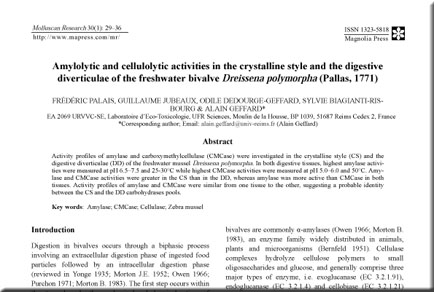Abstract
Activity profiles of amylase and carboxymethylcellulase (CMCase) were investigated in the crystalline style (CS) and the digestive diverticulae (DD) of the freshwater mussel Dreissena polymorpha. In both digestive tissues, highest amylase activities were measured at pH 6.5–7.5 and 25-30°C while highest CMCase activities were measured at pH 5.0–6.0 and 50°C. Amylase and CMCase activities were greater in the CS than in the DD, whereas amylase was more active than CMCase in both tissues. Activity profiles of amylase and CMCase were similar from one tissue to the other, suggesting a probable identity between the CS and the DD carbohydrases pools.

